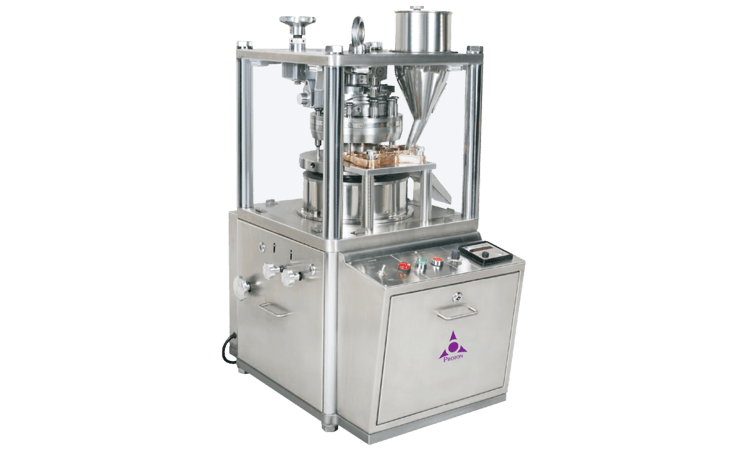Pharmaceutical Mini Tablet Press Machine

A mini tablet press is commonly used across the pharmaceutical sector to compress and shape powders into tablets of diverse shapes and sizes found in research and development laboratories, pilot plants, and small-scale production units.
Typically, a mini tablet press consists of a hopper. Its primary role is to compress the powder. Then, there is a feeder to control the quantity of powder, a turret with multiple punches, and dies, and a compression mechanism to press the powder into tablets. The compression force is adjustable to produce tablets of -varying hardness.
Mini tablet press machinery can be either manual or automatic. The automated version offers higher production rates and more consistent tablet quality. They can also be equipped with additional features such as tablet thickness and weight control, dust extraction systems, and tablet ejection systems.
Mini Tablet Press Machines
| Model | Proton-Mini – 8D | Proton-Mini – 10B | Proton-Mini – 10D |
|---|---|---|---|
| Number of Station | 8 Stn. | 10 Stn. | 10 Stn. |
| Type of Tooling | “D” | “B” | “D” |
| Output-Tablets /Hr. (Max) | 14000 | 18000 | 18000 |
| Turret RPM (Max) | 30 | 30 | 30 |
| Max. Operating Pressure | 6 Tons | 6 Tons | 6 Tons |
| Max. Tablet Diameter | 22 mm | 16 mm | 22 mm |
| Max. Depth of Fill | 20.5 mm | 17.5 mm | 20.5 mm |
| Upper Punch Penetration | 2 to 6 mm | 2 to 6 mm | 2 to 6 mm |
| Dia. of Die mm | 38.10 mm | 30.15 mm | 38.10 mm |
| Length of Die mm | 23.81 mm | 22.22 mm | 23.81 mm |
| Dia. of Punch mm | 25.34 | 18.99 | 25.34 |
| Length of Punch mm | 133.65 mm | 133.65 mm | 133.65 mm |
| Power | 2.0 HP x 1440 PM x 415 V. x 50 Hz | ||
| Overall Dimensions (mm) | 480 x 670 x 1050 | ||
| Net Weight (Kgs.) | 375 | ||
*Specifications are subjected to change without notice.
Frequently Asked Questions
A: A tablet press machine, also known as a tablet compression machine, is used to compress powder into tablets of uniform size, shape, and weight, commonly used in pharmaceutical, nutraceutical, and other industries.
A: Regular maintenance includes cleaning the machine after each use, lubricating moving parts, inspecting dies and punches for wear, and conducting periodic calibration to ensure accurate tablet production.
A: There are two main types of tablet press machines: single-station (single punch) and multi-station (rotary) presses. Single-station presses are used for small-scale production, while rotary presses are designed for high-volume manufacturing.
A: Consider factors such as production capacity, tablet size and shape requirements, material properties, ease of operation, and budget. Consulting with a manufacturer or supplier can also help you select the most suitable machine for your specific application.
Yes, we offer comprehensive training programs for operators and maintenance staff, as well as ongoing technical support to help you maximize your machine’s efficiency and productivity.
Absolutely. We can customize our tablet press machines to meet specific requirements, including unique tablet shapes, sizes, and formulations. Contact us to discuss your customization needs.
Request a call back
For Business: Do you have questions about how Proton Engineers can help your company? Send us an email sales@protonengineers.com and we’ll get in touch shortly, or phone +91 89055 34795 — we would be delighted to speak.
